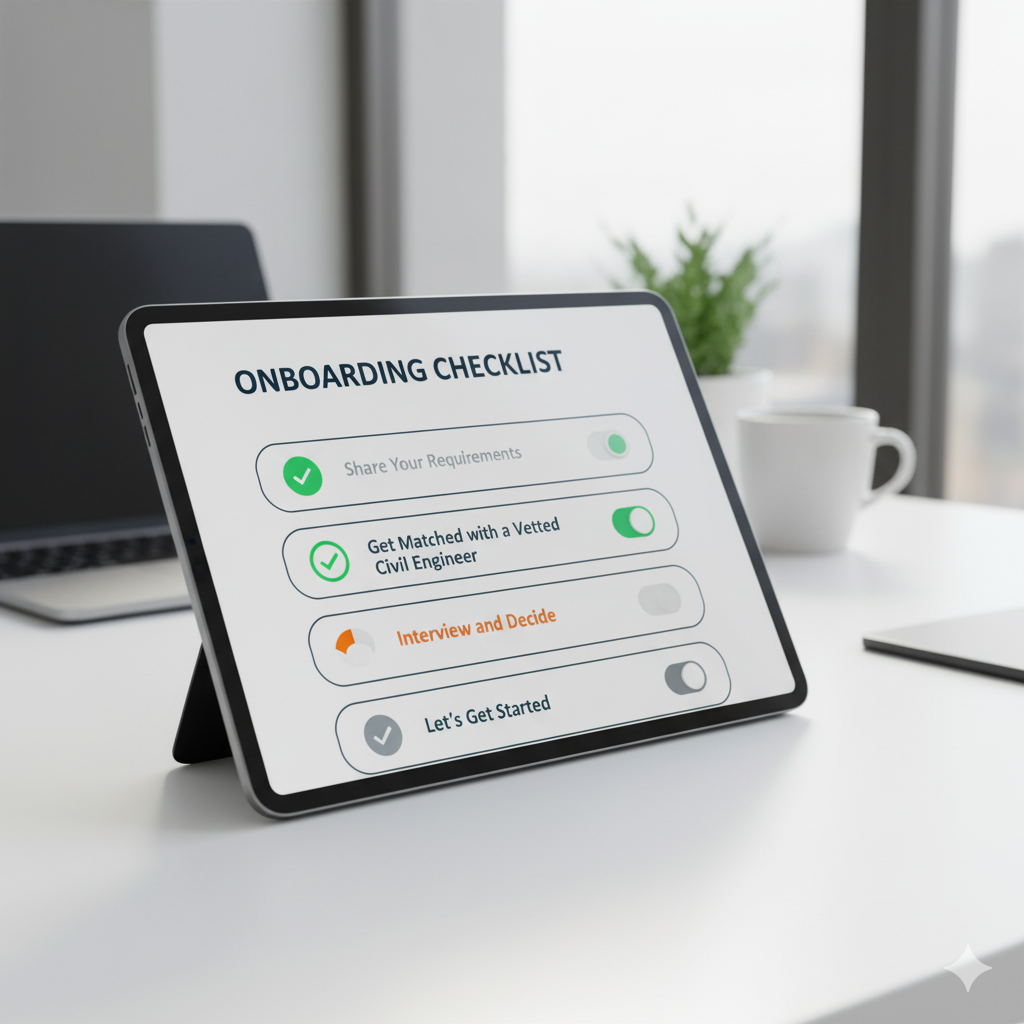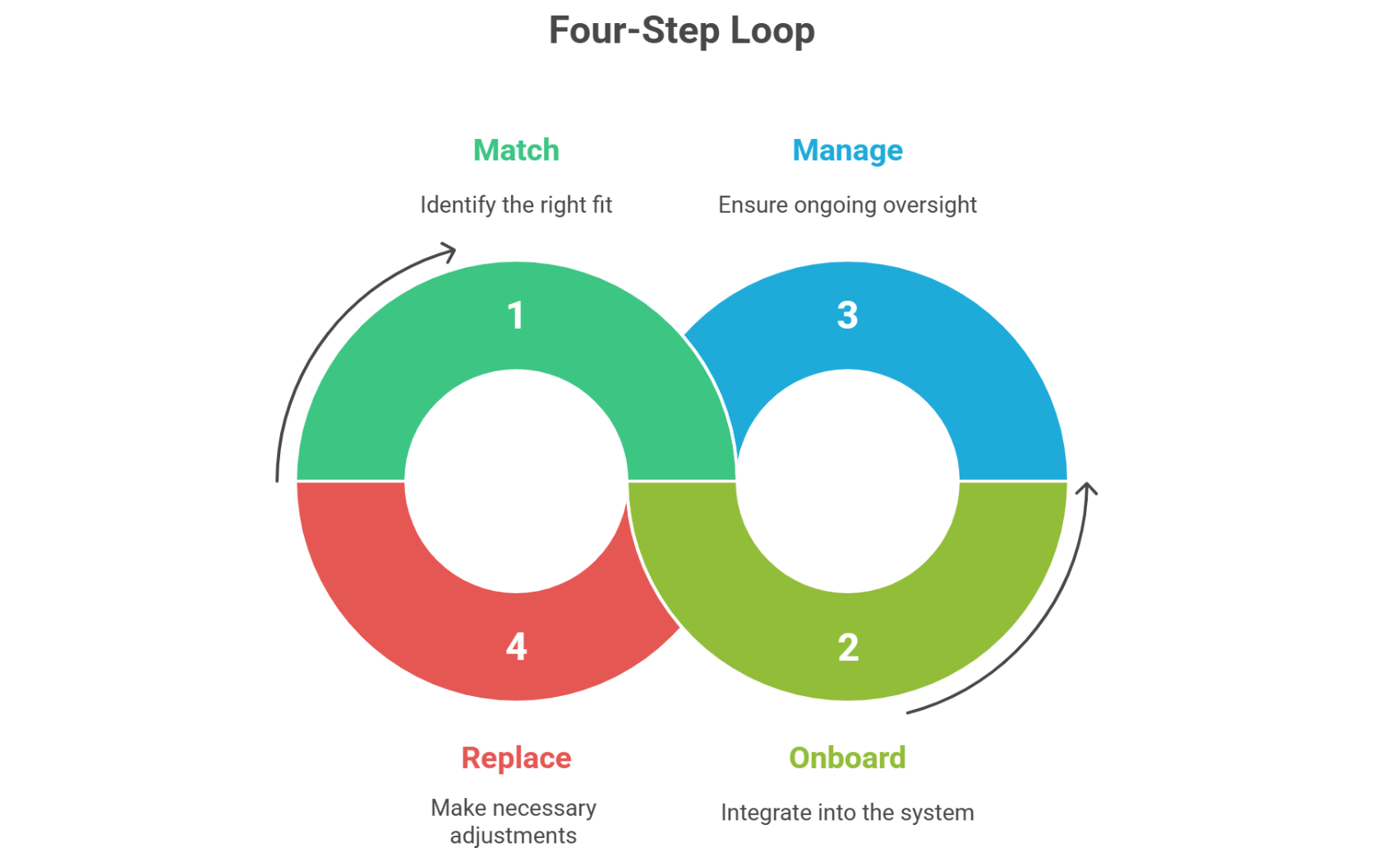
Civil work stalls when hiring drags and budgets tighten. A remote civil engineer solves both. You get a vetted, full-time resource working inside your stack, AutoCAD, Civil 3D, Revit, STAAD, without office overhead. Labor shortages are real: 94% of U.S. construction firms struggled to hire in 2024 (AGC, 2024). Across U.S. employers in 2024, the average time-to-fill was ~41–46 days, with construction and engineering among sectors seeing notable declines. That delay hurts schedules and bids.
Remote AE matches talent in days, then supports onboarding and performance. You keep control. They bring capacity. The outcome: predictable cost, faster start, and steady delivery backed by the construction industry’s outsourcing experience.
Local hiring faces three walls: a tight talent pool, rising salaries, and slow recruitment. Reports show persistent shortages causing project delays across construction (AGC Workforce Survey, 2024). Global hiring widens the pool and cuts the clock. The WEF Future of Jobs 2023 also flags rapid skills shifts, pushing firms to tap broader markets for technical roles. Civil engineering demand remains strong, 23,600 openings per year in the U.S. over the decade (BLS, 2024), so staying local only narrows options. With Remote AE, you interview pre-vetted engineers and start work without waiting two months to staff the seat.
Remote AE’s process allows you to outsource civil engineering tasks without losing control. Engineers integrate directly into your workflow, using shared tools like Civil 3D, BIM 360, and QGIS while reporting daily to your internal project managers.
The biggest advantage? Cost predictability.
When you hire a dedicated civil engineer monthly, you eliminate variable expenses such as office space, HR, and equipment. Instead, you get a single fixed cost that covers full-time work and full accountability.
Typical cost structure comparison:
Additional benefits include:
The combination of remote collaboration tools, structured communication, and expert QA/QC oversight allows firms to maintain design quality while saving 30–50% in total cost.

Remote AE doesn’t offer freelancers; it provides dedicated, full-time engineers who specialize in your type of project, from residential subdivisions and right-of-way design to stormwater systems and traffic studies.
Every project is unique, from land grading and drainage to highway and utility design. That’s why Remote AE doesn’t assign random staff; it handpicks engineers based on domain expertise and software proficiency.
Examples of specialization include:
Each remote civil engineer is matched to your project’s LOD (Level of Detail), workflow, and regional permitting standards.
Unlike freelancers juggling multiple clients, Remote AE provides dedicated civil engineers who work exclusively for your firm.
Key distinctions between freelance vs. dedicated models:
You’ll manage the engineer as part of your in-house team, ensuring:
This model is ideal for firms handling ongoing civil design, permitting, or BIM documentation, allowing them to scale without adding permanent headcount.

Hiring a remote civil engineer through Remote AE is built for speed and reliability. The process is transparent, structured, and designed for construction and engineering firms that need talent ready to contribute from day one.
You start by describing the type of project: land development, stormwater design, roadway geometry, or site grading. A dedicated account manager helps refine your needs, outlining deliverables like drainage plans, cut/fill reports, or erosion control details. You’ll define expected software skills, AutoCAD, Civil 3D, MicroStation, QGIS, or BIM, along with project deadlines.
Remote AE maintains a curated pool of engineers trained in Civil 3D, HEC-RAS, SWMM, HEC-HMS, and hydrology/hydraulic modeling.
Every candidate is screened for:
Each engineer is evaluated for fit with your firm’s workflow, permitting standards, and review process.
You’ll meet up to two shortlisted engineers through a virtual interview. No financial commitment, just an opportunity to assess experience with site plan preparation, contour modeling, subdivision layouts, and RFI documentation. Afterward, you can say, “Let’s proceed,” or pause, no pressure.
Once you select your civil engineer, onboarding begins.
Remote AE’s pricing model:
Includes a 30-day money-back guarantee for risk-free hiring.
Step 5: Seamless Onboarding
Your onboarding transition meeting (30 minutes) covers:
Remote AE coordinates every detail, from software access to mentoring, to make the transition effortless.

Remote AE’s model adds capacity and integrates engineering expertise into your existing workflow.
Tap a global bench of licensed, battle-tested civil engineers, site development, transportation, water resources, geotech, structural, already fluent in AutoCAD, Civil 3D, Revit, STAAD, HEC-RAS. This bypasses local shortages that keep projects waiting.
You direct the work; we remove fixed costs. No office lease, HR burden, or extra seats beyond what you approve. Compared with the U.S. baseline compensation, civil engineers median $99,590 (May 2024), before benefits and space. A remote model converts that stack to a predictable operating expense while keeping your PM in charge.
Hire a civil 3D engineer remotely within days. Ramp up for large land development or infrastructure projects and scale down post-delivery, with no long-term payroll constraints.
Each engineer works exclusively for your firm, no project hopping. Remote AE conducts follow-ups within the first six weeks to confirm satisfaction and address any technical or communication issues.
Guaranteed experience: every Remote AE engineer brings 5+ years of AEC experience and proven civil documentation results.
We plug into your channels (Teams/Slack), meetings, and trackers. Expect crisp daily updates and a weekly KPI snapshot (throughput, turnaround, QA hit rate).

| Aspect | Traditional Hiring | Remote AE Model |
| Hiring Time | Weeks to months | Few days |
| Cost | High (office, HR, tools) | Fixed monthly fee |
| Scalability | Limited | Easy to scale up/down |
| Flexibility | Bound by location | Global availability |
| Control | In-house | Remote but dedicated |
Case snippet: A U.S. municipal program needed Civil 3D corridor updates across three arterials. A Remote AE engineer cleared a design QA backlog in one week, aligning with broader industry evidence that process discipline and access to skilled talent reduce rework and delays.

At Remote AE, we connect AEC firms with full-time civil engineers skilled in Civil 3D, site grading, hydrology, stormwater design, and permitting support. Each engineer works exclusively for your team under a fixed monthly model, no overhead, no HR complexity, just consistent output. Contact Remote AE today to discuss your project scope and see how our remote civil engineering services can help you scale faster, save costs, and deliver projects on time.
Remote civil engineers use cloud-based platforms like Autodesk Construction Cloud, BIM 360, or Procore to exchange drawings, markups, and RFIs. Coordination meetings are held through Teams or Zoom, and model sharing is done via CDEs (Common Data Environments) to maintain version control.
Common tools include AutoCAD Civil 3D, Revit, InfraWorks, Civil Site Design, HEC-RAS, and Bluebeam for markup. Collaboration often involves Navisworks for clash checks and Procore or ACC for document management.
Yes, if they’re guided by a licensed U.S. engineer of record. Remote staff can prepare drawings, calculations, and BIM data, but local code compliance and stamping remain the responsibility of a state-licensed professional.
By hiring from Remote AE, typical monthly costs range from $1,600–$2,000 USD, depending on experience, software proficiency, and region. This is often 40–60% lower than U.S. payroll costs for similar roles.
Yes, much of the design and documentation can be done remotely. Site data is shared through survey uploads, drone imagery, or LiDAR scans. Local inspectors or field partners can handle on-site verification.